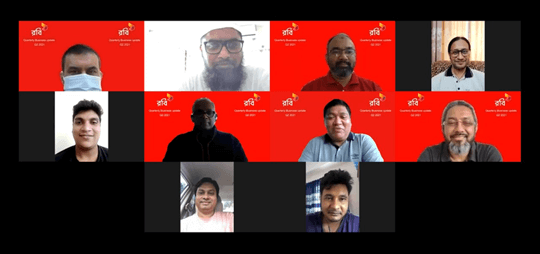Robi maintains strong growth momentum with 47 crore taka profit
Market power concentration in one dominant player destroying competition landscape
KEY HIGHLIGHTS – Q2’21 (April-June)
- 5 Crore 18 lakhs active subscribers with 29.4% subscriber market share
- 3 Crore 75 lakhs internet subscribers, which is 72.4% of the total subscriber base
- Revenue: 2,031 crore taka, which is 2.5%higher than last quarter
- EBITDA: 854 crore taka with 42.1% margin; EBITDA grew by 5.2% compared to the last quarter
- Capex investment: 584 crore taka
- Profit After Tax (PAT): 47 crore taka
- Contribution to the Government Exchequer: 1,138 crore taka, which is 56% of Robi’s total revenue for the quarter
Dhaka, 28 April 2021: Robi ended the second quarter of the year with profit after tax (PAT) of 47 crore taka. Supported by steadily rising revenue and efficient cost management, the company’s PAT for the first half of the year reached 81 crore taka. Robi’s financial results for Q2’21 was released today at a virtual press briefing event.
Compared to Q1’21, Robi’s 4G subscriber base grew by 7.5% in Q2’21, but compared to the same quarter last year, its 4G subscriber base grew by 65%. Out of a total subscriber base of 5 crore 18 lakhs, close to 2 crore are 4G subscribers. Besides, 72.4% of the company’s subscribers are now data users, which is highest in the industry; per user data usage per month is also rising rapidly- it now stands at 3.9GB, indicating that Robi’s strong 4.5G network is winning the confidence of the digitally savvy customers.
Although the subscriber base grew by 8.1% compared to the same quarter last year, compared to the last quarter, Robi’s subscriber base declined marginally by 0.2% in Q2’21. Robi’s subscriber market share stood at 29.4% at the end of Q2’21.
Despite the pandemic related lockdown, Robi’s revenue reached 2,031 crore taka following a rise of 2.5% in Q2’21, compared to the last quarter. Compared to the same quarter last year, Robi’s revenue rose by 15.2%. Voice revenue grew by 1.4% in Q2’21, compared to the last quarter, but compared to the same quarter last year, voice revenue grew by 13.7%.
Data revenue on the other hand have been speeding up at a faster rate with 3.6% growth in Q2’21, compared to the last quarter. Compared to the same quarter last year, Robi’s data revenue grew steeply by 21.9%.
Robi’s EBITDA in Q2’21 stood at 854 crore taka, following a rise of 5.2% compared to the last quarter, but compared to the same quarter last year, EBITDA declined by 3.2%. EBITDA margin at the end of Q2’21 stood at 42.1%.
The company’s earnings per share (EPS) at the end of Q2’21 reached 0.09 taka, following a rise of 36% compared to last quarter, compared to the same quarter last year, the underlying EPS growth rate was 17.8%. Steadily rising EPS is the result of organic EBITDA growth.
Robi made capex investment of 584 crore taka in Q2’21 to expand its 4G network. The company had 13,545 4G sites at the end of Q2’21 ensuring 98% population coverage; it was the first company to deploy 4G technology in 100% of its network. Robi paid 1,138 crore taka to the Government exchequer which was 56% of its revenue for the quarter.
Commenting on the financial performance of the company, Robi’s Managing Director and CEO, Mahtab Uddin Ahmed said: “We are very happy to see that our digital vision has already begun to contribute significantly to our financial performance. We are efficiently managing our cost while continuing with experiments with innovative digital technologies to future-proof the company.
Reflecting on the company’s role in the pandemic situation, he added: “We are proud to be supporting the national call center, 333, which has been repurposed to serve the citizens as the Covid helpline. 333 is also enabling digital service delivery to citizens at their doorsteps. With Robi-10 Minute School, we are providing quality educational content to more than 3 million students of all ages every day.”
But the regulatory landscape continues to concern Mahtab. Citing the lack of effective implementation of the SMP regulation, he observed that the overall competitive distortions are pushing the market to the brink of failure, and such fragile state of the competitive landscape is making it difficult to achieve the condition of economic efficiency.
Mahtab noted that distorted price mechanism and distribution system are undermining consumers’ interest and weakening the telecom industry to the detriment of the Digital Bangladesh vision. He stressed that for a market to operate efficiently, no single entity should be allowed to dictate the price and output decisions. However, in our market, the presence of significant monopoly power is discouraging the competition from investing in innovative digital technologies that are crucial to the future of the country, he quipped.


